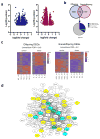Transgenerational inheritance of chronic adolescent stress: Effects of stress response and the amygdala transcriptome
- PMID: 29896789
- PMCID: PMC6292780
- DOI: 10.1111/gbb.12493
Transgenerational inheritance of chronic adolescent stress: Effects of stress response and the amygdala transcriptome
Abstract
Adolescent stress can impact health and well-being not only during adulthood of the exposed individual but even in future generations. To investigate the molecular mechanisms underlying these long-term effects, we exposed adolescent males to stress and measured anxiety behaviors and gene expression in the amygdala-a critical region in the control of emotional states-in their progeny for two generations, offspring and grandoffspring. Male C57BL/6 mice underwent chronic unpredictable stress (CUS) for 2 weeks during adolescence and were used to produce two generations of offspring. Male and female offspring and grandoffspring were tested in behavioral assays to measure affective behavior and stress reactivity. Remarkably, transgenerational inheritance of paternal stress exposure produced a protective phenotype in the male, but not the female lineage. RNA-seq analysis of the amygdala from male offspring and grandoffspring identified differentially expressed genes (DEGs) in mice derived from fathers exposed to CUS. The DEGSs clustered into numerous pathways, and the "notch signaling" pathway was the most significantly altered in male grandoffspring. Therefore, we show that paternal stress exposure impacts future generations which manifest in behavioral changes and molecular adaptations.
Keywords: RNA-sequencing; adolescent stress; amygdala; chronic unpredictable stress; inheritance; multi-generational; notch signaling; stress; transcriptome; transgenerational.
© 2018 John Wiley & Sons Ltd and International Behavioural and Neural Genetics Society.
Figures



Similar articles
-
Elevated paternal glucocorticoid exposure modifies memory retention in female offspring.Psychoneuroendocrinology. 2017 Sep;83:9-18. doi: 10.1016/j.psyneuen.2017.05.014. Epub 2017 May 18. Psychoneuroendocrinology. 2017. PMID: 28554167
-
Oligodendrocyte gene expression is reduced by and influences effects of chronic social stress in mice.Genes Brain Behav. 2019 Jan;18(1):e12475. doi: 10.1111/gbb.12475. Epub 2018 Apr 17. Genes Brain Behav. 2019. PMID: 29566304
-
Paternal environmental enrichment transgenerationally alters affective behavioral and neuroendocrine phenotypes.Psychoneuroendocrinology. 2017 Mar;77:225-235. doi: 10.1016/j.psyneuen.2016.11.013. Epub 2017 Jan 4. Psychoneuroendocrinology. 2017. PMID: 28104556
-
Transgenerational inheritance of stress pathology.Exp Neurol. 2012 Jan;233(1):95-101. doi: 10.1016/j.expneurol.2011.01.009. Epub 2011 Jan 31. Exp Neurol. 2012. PMID: 21281632 Review.
-
Transgenerational inheritance: how impacts to the epigenetic and genetic information of parents affect offspring health.Hum Reprod Update. 2019 Sep 11;25(5):518-540. doi: 10.1093/humupd/dmz017. Hum Reprod Update. 2019. PMID: 31374565
Cited by
-
Differential susceptibility of male and female germ cells to glucocorticoid-mediated signaling.bioRxiv [Preprint]. 2023 Oct 11:2023.06.30.547215. doi: 10.1101/2023.06.30.547215. bioRxiv. 2023. Update in: Elife. 2024 Jan 16;12:RP90164. doi: 10.7554/eLife.90164. PMID: 37425891 Free PMC article. Updated. Preprint.
-
Generational synaptic functions of GABAA receptor β3 subunit deteriorations in an animal model of social deficit.J Biomed Sci. 2022 Jul 11;29(1):51. doi: 10.1186/s12929-022-00835-w. J Biomed Sci. 2022. PMID: 35821032 Free PMC article.
-
Epigenetic Mechanisms of Paternal Stress in Offspring Development and Diseases.Int J Genomics. 2021 Jan 19;2021:6632719. doi: 10.1155/2021/6632719. eCollection 2021. Int J Genomics. 2021. PMID: 33532485 Free PMC article. Review.
-
Post-Developmental Roles of Notch Signaling in the Nervous System.Biomolecules. 2020 Jul 1;10(7):985. doi: 10.3390/biom10070985. Biomolecules. 2020. PMID: 32630239 Free PMC article. Review.
-
Mapping the past, present and future research landscape of paternal effects.BMC Biol. 2020 Nov 27;18(1):183. doi: 10.1186/s12915-020-00892-3. BMC Biol. 2020. PMID: 33246472 Free PMC article.
References
-
- Gapp K, Bohacek J. Epigenetic germline inheritance in mammals: looking to the past to understand the future. Genes, Brain and Behavior. 2017 - PubMed
-
- Matthews SG, Phillips DI. Transgenerational inheritance of stress pathology. Experimental Neurology. 2012:95–101. - PubMed
-
- Franklin TB, et al. Epigenetic Transmission of the Impact of Early Stress Across Generations. Biological Psychiatry. 2010:408–415. - PubMed
Publication types
MeSH terms
Grants and funding
LinkOut - more resources
Full Text Sources
Other Literature Sources
Medical
Molecular Biology Databases

